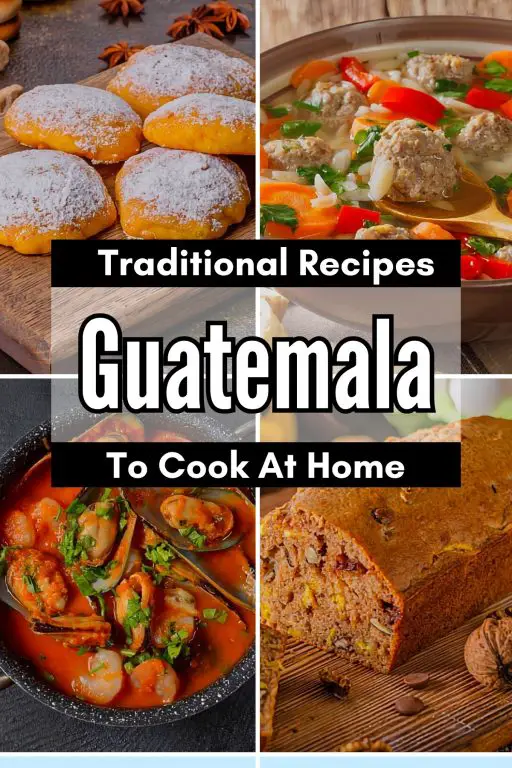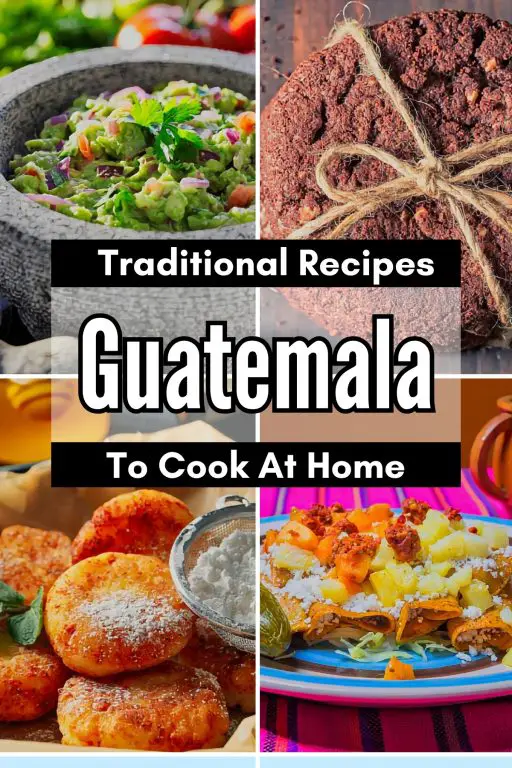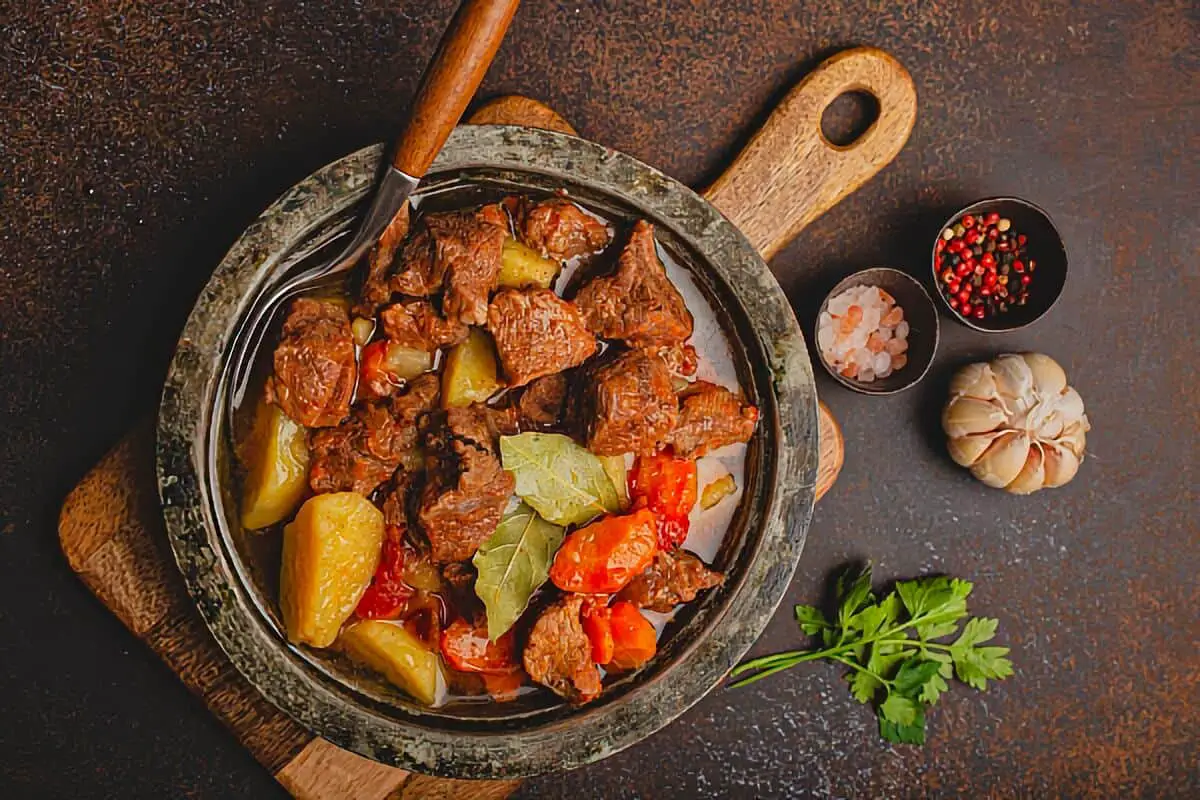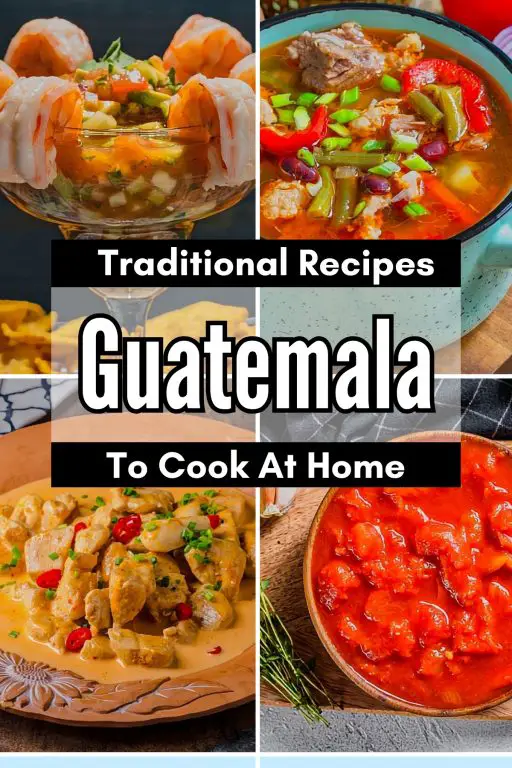My Guatemalan Pulique recipe comes from a cooking class in Guatemala City, we focused solely on making this Pulique recipe. This vibrant capital is famous for its history, cultural sites, and markets. Guatemala City mixes contemporary living with traditional Guatemalan culture. While I was there, I learned more about the local food in a hands-on cooking class.
In class, we made pulique, which is a traditional dish made with chicken, vegetables, and spices. The teacher talked about how important pulique is in Guatemalan culture. It is served at family get-togethers and celebrations. The first step was to marinate the chicken with herbs and spices. I enjoyed how the ingredients came together to create a really nice smell for the dish as we cooked.
I found the Guatemalan Pulique recipe to be straightforward and uncomplicated. The chicken and vegetables, like carrots and potatoes, made it look really filling. We also had corn tortillas, which are a basic part of Guatemalan meals, with the pulique. The chicken turned out moist and juicy after cooking, and the vegetables had a nice crunch.
As we cooked, the kitchen filled with delicious smells – it’s a hearty meal. The pulique has a rich sauce that is tasty and a bit spicy. The flavor is well-balanced and highlights the natural tastes of the chicken and vegetables. Every bite felt warm and highlighted the basic ingredients, all while being a satisfying meal.
People in Guatemala often prepare Pulique at restaurants and at home. Different families create their own versions of the dish, sometimes adding different vegetables or spices based on what they like. When I went to local markets in Guatemala City, I saw some vendors selling homemade pulique. This dish is particularly loved during festivals when families come together to share traditional meals.
After the cooking class, I went to explore some sights in Guatemala City. I visited the National Palace and the Metropolitan Cathedral, which show the country’s history and architecture. I discovered more about the culture by exploring the city and seeing how food brings people together.
I thought learning the Guatemalan Pulique recipe was interesting and enjoyable. I discovered traditional cooking and the importance of pulique in Guatemalan culture. This dish is typical of Guatemalan cuisine because it uses simple ingredients and has great flavor. At a family gathering or a local restaurant, the pulique is still a favorite part of the country’s food traditions.
Ingredients For the Guatemalan Pulique Recipe
Chicken or Beef Cut Into Pieces
Fresh or Frozen Corn Kernels
Pumpkin Seeds
Diced Ripe Tomatoes
Diced Tomatillos Husked and Diced
Chopped Onion
Minced Garlic Cloves
Vegetable Oil
Dried Oregano
Ground Cumin
Chicken Broth
Salt
Pepper
Cooking Instructions For the Guatemalan Pulique Recipe
In a large pot, heat the vegetable oil over medium heat. Add the chopped onion and minced garliCook until the onion becomes translucent. – Sauté the onion and garlic until translucent. Cook the onion and garlic until they turn soft and fragrant. Sauté the onion and garlic until they become tender and golden. Stir-fry the onion and garlic until they release their aroma. Warm the oil in a pot and cook the onion and garlic until they are lightly browned.
Add the chicken pieces to the pot and cook until they are browned on all sides. – Place the chicken in the pot and sauté until it turns golden and crispy. Add the chicken to the pot and cook until it develops a nice, browned crust. Put the chicken into the pot and sear it until it becomes beautifully caramelized. Place the chicken in the pot and cook until it is nicely browned on all sides. Add the chicken to the pot and sauté until it achieves a golden, crispy exterior.
Stir in the diced tomatoes, diced tomatillos, dried oregano, and ground cumin. Cook for a few minutes until the tomatoes and tomatillos begin to soften. – Mix in the diced tomatoes, diced tomatillos, dried oregano, and ground cumin. Simmer until the tomatoes and tomatillos turn tender. Incorporate the diced tomatoes, diced tomatillos, dried oregano, and ground cumin.
Allow the mixture to cook until the tomatoes and tomatillos start to break down. Combine the diced tomatoes, diced tomatillos, dried oregano, and ground cumin. Cook until the tomatoes and tomatillos become slightly tender. Add the diced tomatoes, diced tomatillos, dried oregano, and ground cumin. Let the mixture cook until the tomatoes and tomatillos soften and release their juices. Mix in the diced tomatoes, diced tomatillos, dried oregano, and ground cumin. Cook until the tomatoes and tomatillos become fragrant and slightly softened.
Pour in the chicken broth and bring the mixture to a boil. Reduce the heat to low, cover the pot, and simmer for about 30 minutes or until the chicken is cooked through and tender. – Add the chicken broth to the pot and bring the mixture to a vigorous boil. Then, lower the heat, cover the pot, and let it simmer for approximately 30 minutes or until the chicken becomes fully cooked and tender. Pour the chicken broth into the pot and bring the mixture to a rolling boil. Then, reduce the heat, cover the pot, and allow it to simmer for about 30 minutes or until the chicken is tender and fully cooked. Incorporate the chicken broth into the pot and bring the mixture to a gentle boil.
Decrease the heat, cover the pot, and let it simmer for approximately 30 minutes or until the chicken is thoroughly cooked and tender. Pour in the chicken broth and bring the mixture to a boil over medium-high heat. Then, reduce the heat, cover the pot, and simmer for about 30 minutes or until the chicken is cooked through and tender. Add the chicken broth to the pot and bring the mixture to a boil. Then, lower the heat, cover the pot, and simmer for approximately 30 minutes or until the chicken becomes fully cooked and tender.
Add the corn kernels and pumpkin seeds to the pot. Cook for an additional 10 minutes to allow the flavors to meld together. – Mix in the corn kernels and pumpkin seeds. Cook for an extra 10 minutes to allow the flavors to blend harmoniously. Incorporate the corn kernels and pumpkin seeds. Cook for another 10 minutes to let the flavors meld together.
Add the corn kernels and pumpkin seeds to the pot. Cook for an additional 10 minutes, allowing the flavors to meld and develop. Stir in the corn kernels and pumpkin seeds. Cook for an extra 10 minutes to enhance the combination of flavors. Mix the corn kernels and pumpkin seeds into the pot. Cook for an additional 10 minutes to ensure the flavors are well incorporated.
 10 Foods Most Eaten by Guatemalan Locals
10 Foods Most Eaten by Guatemalan Locals
1. Pepián – A thick, aromatic stew made with chicken, beef, or pork, cooked in a rich sauce of roasted tomatoes, pumpkin seeds, and chili peppers. Pepián is traditionally served with rice and is one of Guatemala’s most cherished dishes.
2. Kak’ik – This turkey soup is spiced with coriander, chili, and achiote, creating a vibrant red color and bold flavor. A UNESCO-recognized dish, Kak’ik is a classic in Mayan cuisine.
3. Tamales – Guatemalan tamales differ from Mexican versions and are typically larger, wrapped in banana leaves, and come in several varieties like *colorados* (red tamales) or *negros* (sweet tamales).
4. Fiambre – A traditional salad prepared during All Saints’ Day, Fiambre is made with over 50 ingredients, including vegetables, meats, cheeses, and sausages, making it a unique and colorful dish.
5. Hilachas – This stew combines shredded beef with potatoes and vegetables in a tomato-based sauce flavored with spices like cilantro and achiote. Hilachas is typically served with rice or corn tortillas.
6. Chiles Rellenos – Guatemalan stuffed peppers are filled with seasoned ground beef, rice, and vegetables, then battered and fried. They’re often served with tomato sauce and are popular in street food markets.
7. Jocon – A green chicken stew made with tomatillos, green tomatoes, and cilantro, Jocon is a flavorful, mild dish usually served with rice.
8. Garnachas – These small, fried tortillas are topped with minced meat, cabbage, and tomato sauce, offering a quick and tasty snack that’s easy to find in markets.
9. Rellenitos – Sweet plantains stuffed with refried black beans and fried to a golden brown, Rellenitos are a favorite dessert or snack, often topped with sugar.
10. Atol de Elote – A warm, sweet corn drink flavored with cinnamon and sugar, Atol de Elote is popular for breakfast or as an afternoon treat, especially during Guatemala’s rainy season.
5 Essiential Ingredients for Guatemalan Food
Guatemalan cuisine is deeply influenced by Mayan traditions, Spanish heritage, and locally sourced ingredients, resulting in a unique flavor profile that combines earthy, tangy, and spicy notes. Among the essential ingredients, corn stands out as a foundational staple. Known as maíz in Spanish, corn is the backbone of many dishes and a cultural symbol in Guatemala.
It is used in various forms, from tortillas that accompany nearly every meal to tamales, which are made with a dough of masa and wrapped in banana leaves. Corn also features in drinks like atol de elote, a warm, sweet corn beverage. This ingredient’s versatility and accessibility make it a crucial part of Guatemalan meals, representing sustenance and tradition.
Chilies are another key ingredient that adds both flavor and heat to Guatemalan food. Though the cuisine is not as intensely spicy as other Central American foods, it often incorporates varieties like the guajillo, cobán, and *pasa* peppers, which add depth without overpowering the dish. These chilies are used in salsas, stews, and sauces, such as the rich sauce in pepian, a traditional meat stew. The use of mild to medium spiciness gives Guatemalan dishes their distinctive warmth and aroma, allowing the natural flavors of other ingredients to shine through.
Tomatoes are essential for the base of many Guatemalan recipes, providing acidity, richness, and natural sweetness. Often roasted to deepen their flavor, tomatoes are combined with chilies, onions, and spices to create rich sauces that are integral to dishes like hilachas (shredded beef stew) and jocon (a green chicken stew). The incorporation of tomatoes reflects Spanish influences while highlighting the country’s abundance of fresh produce.
Another indispensable ingredient is pepitoria, or pumpkin seeds. Ground pumpkin seeds are used to thicken sauces, add texture, and enhance flavors, particularly in stews and traditional dishes. In pepian, for instance, pepitoria gives the sauce a nutty undertone that balances the spices and brings a subtle richness. This ingredient not only adds depth but also reflects Guatemala’s pre-Columbian culinary heritage, as pumpkin seeds have been used in the region for centuries.
Finally, achiote (annatto) brings vibrant color and a mild, peppery flavor to Guatemalan food. The seeds are often ground into a paste or oil and used as a seasoning or natural colorant, giving dishes an appealing reddish hue. Achiote’s subtle flavor enhances recipes like recado rojo, a red sauce for meats and poultry. Together, these five ingredients — corn, chilies, tomatoes, pepitoria, and achiote — embody the flavors, history, and culinary creativity of Guatemalan cuisine, forming the foundation of its most cherished dishes.
 FAQ For the Guatemalan Pulique Recipe
FAQ For the Guatemalan Pulique Recipe
Q: What are the key ingredients in the Guatemalan Pulique recipe?
A: The Guatemalan Pulique recipe features a rich blend of ingredients that create a hearty and flavorful dish. The primary components include chicken or pork, which is typically seasoned and cooked until tender. The dish also incorporates vegetables such as tomatoes, bell peppers, and onions, along with spices like garlic and cilantro to enhance the flavor. Additionally, masa (corn dough) is used to thicken the soup, giving it a unique texture that distinguishes Pulique from other stews.
Q: How do you prepare the Guatemalan Pulique recipe?
A: To prepare the Guatemalan Pulique recipe, start by sautéing the chopped onions, garlic, and bell peppers in a large pot until they are soft and fragrant. Then, add the seasoned meat and cook until browned. Next, incorporate the tomatoes, water or broth, and any additional spices, allowing the mixture to simmer until the meat is tender. Finally, mix in the masa dough to thicken the broth, stirring continuously to ensure there are no lumps. Cook for an additional 15-20 minutes to meld the flavors together before serving hot.
Q: What side dishes pair well with the Guatemalan Pulique recipe?
A: The Guatemalan Pulique recipe can be complemented by a variety of side dishes that enhance its robust flavors. Common pairings include rice or tortillas, which can help soak up the savory broth. Additionally, a simple side salad or pickled vegetables can add a refreshing contrast to the richness of the Pulique. These sides not only balance the meal but also provide a complete dining experience that celebrates the traditional flavors of Guatemalan cuisine.
Q: Can I make substitutions in the Guatemalan Pulique recipe?
A: Yes, you can make several substitutions in the Guatemalan Pulique recipe to cater to dietary preferences or ingredient availability. For instance, if you prefer a vegetarian version, you can substitute the meat with mushrooms or a mix of hearty vegetables like zucchini and carrots. Similarly, using vegetable broth instead of chicken or pork broth will maintain the dish’s flavor profile while accommodating vegetarian diets. Just ensure that any substitutes are seasoned appropriately to achieve a similar depth of flavor in the final dish.
Q: How do I store leftovers from the Guatemalan Pulique recipe?
A: To store leftovers from the Guatemalan Pulique recipe, allow the dish to cool to room temperature before transferring it to an airtight container. Properly stored in the refrigerator, Pulique can last for up to three days. When reheating, be sure to do so gently on the stovetop, adding a splash of water or broth to restore the original consistency, as the masa may thicken the soup further upon cooling. This method helps maintain the flavors and texture of the dish for your next meal.

Guatemalan Pulique Recipe
Equipment
- Large pot: This will be used to cook the Guatemalan Pulique stew.
- Cutting board: Used for chopping vegetables and preparing ingredients.
- Knife: Essential for cutting the chicken, onions, garlic, and other ingredients.
- Wooden spoon: Used for stirring and mixing the ingredients in the pot.
- Ladle: For serving the Guatemalan Pulique into bowls.
- Measuring cups: Needed to measure the corn kernels, pumpkin seeds, and chicken broth accurately.
- Tongs: Useful for handling the chicken pieces during the browning process.
- Can opener: If using canned ingredients like diced tomatoes or tomatillos.
Ingredients
- 2.5 pounds chicken cut into pieces
- 2 cups corn fresh or frozen
- 1 cup pumpkin seeds
- 4 tomatoes ripe and diced
- 4 tomatillos husked and diced
- 1 onion large and chopped
- 4 garlic cloves minced
- 2 tablespoons vegetable oil
- 2 teaspoons oregano dried
- 2 teaspoons cumin
- 8 cups broth
- Salt and pepper to taste
Instructions
In a large pot, heat the vegetable oil over medium heat. Add the chopped onion and minced garlic. Cook until the onion becomes translucent.
- a. Sauté the onion and garlic until translucent.
- b. Cook the onion and garlic until they turn soft and fragrant.
- c. Sauté the onion and garlic until they become tender and golden.
- d. Stir-fry the onion and garlic until they release their aroma.
- e. Warm the oil in a pot and cook the onion and garlic until they are lightly browned.
Add the chicken pieces to the pot and cook until they are browned on all sides.
- a. Place the chicken in the pot and sauté until it turns golden and crispy.
- b. Add the chicken to the pot and cook until it develops a nice, browned crust.
- c. Put the chicken into the pot and sear it until it becomes beautifully caramelized.
- d. Place the chicken in the pot and cook until it is nicely browned on all sides.
- e. Add the chicken to the pot and sauté until it achieves a golden, crispy exterior.
Stir in the diced tomatoes, diced tomatillos, dried oregano, and ground cumin. Cook for a few minutes until the tomatoes and tomatillos begin to soften.
- a. Mix in the diced tomatoes, diced tomatillos, dried oregano, and ground cumin. Simmer until the tomatoes and tomatillos turn tender.
- b. Incorporate the diced tomatoes, diced tomatillos, dried oregano, and ground cumin. Allow the mixture to cook until the tomatoes and tomatillos start to break down.
- c. Combine the diced tomatoes, diced tomatillos, dried oregano, and ground cumin. Cook until the tomatoes and tomatillos become slightly tender.
- d. Add the diced tomatoes, diced tomatillos, dried oregano, and ground cumin. Let the mixture cook until the tomatoes and tomatillos soften and release their juices.
- e. Mix in the diced tomatoes, diced tomatillos, dried oregano, and ground cumin. Cook until the tomatoes and tomatillos become fragrant and slightly softened.
Pour in the chicken broth and bring the mixture to a boil. Reduce the heat to low, cover the pot, and simmer for about 30 minutes or until the chicken is cooked through and tender.
- a. Add the chicken broth to the pot and bring the mixture to a vigorous boil. Then, lower the heat, cover the pot, and let it simmer for approximately 30 minutes or until the chicken becomes fully cooked and tender.
- b. Pour the chicken broth into the pot and bring the mixture to a rolling boil. Then, reduce the heat, cover the pot, and allow it to simmer for about 30 minutes or until the chicken is tender and fully cooked.
- c. Incorporate the chicken broth into the pot and bring the mixture to a gentle boil. Then, decrease the heat, cover the pot, and let it simmer for approximately 30 minutes or until the chicken is thoroughly cooked and tender.
- d. Pour in the chicken broth and bring the mixture to a boil over medium-high heat. Then, reduce the heat, cover the pot, and simmer for about 30 minutes or until the chicken is cooked through and tender.
- e. Add the chicken broth to the pot and bring the mixture to a boil. Then, lower the heat, cover the pot, and simmer for approximately 30 minutes or until the chicken becomes fully cooked and tender.
Add the corn kernels and pumpkin seeds to the pot. Cook for an additional 10 minutes to allow the flavors to meld together.
- a. Mix in the corn kernels and pumpkin seeds. Cook for an extra 10 minutes to allow the flavors to blend harmoniously.
- b. Incorporate the corn kernels and pumpkin seeds. Cook for another 10 minutes to let the flavors meld together.
- c. Add the corn kernels and pumpkin seeds to the pot. Cook for an additional 10 minutes, allowing the flavors to meld and develop.
- d. Stir in the corn kernels and pumpkin seeds. Cook for an extra 10 minutes to enhance the combination of flavors.
- e. Mix the corn kernels and pumpkin seeds into the pot. Cook for an additional 10 minutes to ensure the flavors are well incorporated.
- Prep Time: 15 minutes
- Cooking Time: 50 minutes
- Pots, Pan and Cooking Equipment Needed for the Guatemalan Pulique Recipe
- Large pot: This will be used to cook the Guatemalan Pulique stew.
- Cutting board: Used for chopping vegetables and preparing ingredients.
- Knife: Essential for cutting the chicken, onions, garlic, and other ingredients.
- Wooden spoon: Used for stirring and mixing the ingredients in the pot.
- Ladle: For serving the Guatemalan Pulique into bowls.
- Measuring cups: Needed to measure the corn kernels, pumpkin seeds, and chicken broth accurately.
- Tongs: Useful for handling the chicken pieces during the browning process.
- Can opener: If using canned ingredients like diced tomatoes or tomatillos.
- Best Way to Store Leftovers From the the Guatemalan Pulique Recipe
- a. Allow the Guatemalan Pulique to cool completely before transferring it to an airtight container.
- b. Store the leftovers in the refrigerator to keep them fresh.
- c. Use glass or plastic containers with tight-fitting lids to maintain the flavors and prevent leakage.
- d. Label the containers with the date to keep track of freshness.
- e. Reheat the leftovers thoroughly before consuming, either on the stovetop or in the microwave.



1 comment
This dish had a thick, comforting consistency and tasted very homey.